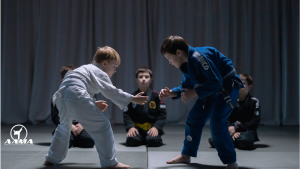
In today’s fast-paced world, leadership skills are essential for success in all areas of life. Whether in the workplace, school, or community, strong leaders inspire and guide others toward a common goal. Surprisingly, one of the most effective ways to develop these qualities isn’t in a boardroom or leadership seminar—it’s through martial arts training. In fact, Forbes recently wrote about lessons that business leaders can learn from Martial Arts.
At American Academies of Martial Arts (AAMA), we see firsthand how martial arts leadership skills shape students into confident, disciplined, and capable leaders.
The Role of Discipline in Leadership
Discipline is one of the foundational traits of both martial artists and great leaders. In martial arts, students learn the value of consistent effort, perseverance, and self-control. Through structured training, they develop the ability to push through challenges, stay focused under pressure, and maintain a strong work ethic—essential qualities for leadership in any field.
Confidence Through Action
Confidence isn’t something that appears overnight; it’s built through experience and overcoming challenges. Martial arts students develop confidence by mastering new skills, advancing through belt ranks, and performing in front of others during testing and competitions. This confidence extends beyond the dojo, helping students speak up in meetings, take initiative in group settings, and approach challenges with a can-do attitude.
Ryan, one of our dedicated students, exemplifies this principle. Initially, he started Kung Fu as a casual activity, but as he progressed, he set his sights on earning his black sash and even becoming an instructor. His journey required persistence and self-discipline, and along the way, he grew into a more confident, self-assured leader among his peers. His experience at AAMA reinforced his ability to set goals and mentor others, key traits of strong leadership.
Respect and Humility: The Hallmarks of a True Leader
Great leaders don’t just command respect; they give it. Martial arts instill respect for instructors, peers, and the learning process. Students bow before stepping onto the mat, demonstrating humility and gratitude for the opportunity to grow. This sense of respect translates into leadership by fostering collaboration, understanding different perspectives, and creating a positive team environment.
Goal-Setting and Perseverance
Martial arts training teaches students to set and achieve goals systematically. Whether working toward a new belt rank or perfecting a challenging technique, students learn the importance of breaking big goals into smaller, manageable steps. This approach mirrors the skills needed to lead a team, complete complex projects, or pursue long-term career success.
The Power of Communication and Presence
Leadership is about more than just making decisions; it’s about inspiring and guiding others. Martial arts training enhances both verbal and non-verbal communication skills. Students learn to project confidence, maintain eye contact, and use their body language effectively. Instructors also emphasize clear, concise communication—essential for giving directions, motivating peers, and resolving conflicts.
Teamwork and Mentorship
While martial arts are often seen as an individual pursuit, they also emphasize teamwork and mentorship. Higher-ranked students assist lower ranks, reinforcing their own skills while developing patience and leadership abilities. This structure mirrors professional mentorship programs, where experienced leaders guide and support emerging talent.
Ryan’s commitment to Kung Fu extended beyond personal achievement. His goal of becoming an instructor wasn’t just about his own progress—it was about sharing his knowledge and helping others grow. His eagerness to mentor younger students is a clear demonstration of how martial arts cultivate leadership qualities that extend beyond the training mat.
Building Resilience for Leadership Challenges
Every leader faces setbacks, and resilience is key to overcoming them. In martial arts, failure is part of the learning process. Whether struggling with a difficult move or losing a sparring match, students develop the mindset that setbacks are opportunities for growth. This resilience enables them to navigate challenges in leadership roles without losing confidence or determination.
Conclusion: Unlock Your Leadership Potential Through Martial Arts
Martial arts leadership skills extend far beyond the training mat, shaping individuals into confident, disciplined, and effective leaders. By embracing the lessons of perseverance, respect, goal-setting, and resilience, students gain the tools needed to excel in leadership roles across all areas of life. Whether you’re looking to build confidence in your child or refine your own leadership abilities, martial arts provide an invaluable foundation for success.
Ready to experience the leadership transformation martial arts can offer? Contact AAMA today to schedule a trial class and start your journey toward confidence, discipline, and leadership excellence.